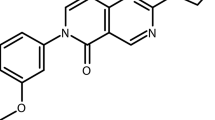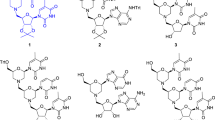Abstract
The antimicrobial biocide triclosan [5-chloro-2-(2,4-dichlorophenoxy)phenol] potently inhibits the growth of Plasmodium falciparum in vitro and, in a mouse model, Plasmodium berghei in vivo. Inhibition of [14C]acetate and [14C]malonyl-CoA incorporation into fatty acids in vivo and in vitro, respectively, by triclosan implicate FabI as its target. Here we demonstrate that the enoyl-ACP reductase purified from P. falciparum is triclosan sensitive. Also, we present the evidence for the existence of FabI gene in P. falciparum. We establish the existence of the de novo fatty acid biosynthetic pathway in this parasite, and identify a key enzyme of this pathway for the development of new antimalarials.
This is a preview of subscription content, access via your institution
Access options
Subscribe to this journal
Receive 12 print issues and online access
$209.00 per year
only $17.42 per issue
Buy this article
- Purchase on Springer Link
- Instant access to full article PDF
Prices may be subject to local taxes which are calculated during checkout




Similar content being viewed by others
References
Rock, C.O. & Cronan, J.E. Escherichia coli as a model for the regulation of dissociable (type II) fatty acid biosynthesis. Biochim. Biophys. Acta. 1302, 1–16 (1996).
Weeks, G. & Wakil, S.J. Studies on the mechanism of fatty acid synthesis. J. Biol. Chem. 243, 1180–1189 (1968).
Turnowsky, F., Fuchs, K., Jeschek, C. & Högenauer, G. envM genes of Salmonella typhimurium and Escherichia coli. J. Bacteriol. 171, 6555–6565 (1989).
Bergler, H. et al. Protein EnvM is the NADH-dependent enoyl-ACP reductase (FabI) of Escherichia coli. J. Biol. Chem. 269, 5493–5496 (1994).
Heath, R.J. & Rock, C.O. Enoyl-acyl carrier protein reductase (FabI) plays a determinant role in completing cycles of fatty acid elongation in Escherichia coli. J. Biol. Chem. 44, 26538–26542 (1995).
Waller, R.F. et al. Nuclear-encoded proteins target to the plastid in Toxoplasma gondii and Plasmodium falciparum. Proc. Natl. Acad. Sci. USA 95, 12352–12357 (1998).
McMurray, L.M., Oethinger, M. & Levy, S.B. Triclosan targets lipid synthesis. Nature 394, 531–532 (1998).
Heath, R.J., Yu, Y.-T., Shapiro, M.A., Olson, E. & Rock, C.O. Broad spectrum antimicrobial biocides target the FabI component of fatty acid synthesis. J. Biol. Chem. 273, 30316–30320 (1998).
Heath, R.J. et al. Mechanism of triclosan inhibition of bacterial fatty acid synthesis. J. Biol. Chem. 274, 11110–11114 (1999).
Vance, D., Goldberg, I., Mitsuhashi, O. & Bloch, K. Inhibition of fatty acid synthetases by the antibiotic cerulenin. Biochem. Biophys. Res. Commun. 48, 649–656 (1972).
Mitruka, M. & Rawnsley, H.M. Clinical, biochemical and hematological reference values in normal experimental animals. (Mason Publishing, New York, 1977).
Matesanz, F., Duran-Chica, I. & Alcina, A. The cloning and expression of pfacs1, a Plasmodium falciparum fatty acid coenzyme A synthetase-1 targeted to the host erythrocyte cytoplasm. J. Mol. Biol. 291, 59–70 (1999).
Haldar, K., Ferguson, M.A.J. & Cross, G.A.M. Acylation of a Plasmodium falciparum merozoite surface antigen via sn-1,2-diacyl glycerol. J. Biol. Chem. 260, 4969–4974 (1985).
Holz, G.G. Jr. Lipids and the malarial parasite. Bull. World Health Organ. 55, 237–248 (1977).
Bergler, H., Fuchsbichler, S., Högenauer, G. & Turnowsky, F. The enoyl-[acyl-carrier-protein] reductase (FabI) of Escherichia coli, which catalyzes a key regulatory step in fatty acid biosynthesis, accepts NADH and NADPH as cofactors and is inhibited by palmitoyl-CoA. Eur. J. Biochem. 242, 689–694 (1996).
Kater, M.M., Koningstein, G.M., Nijkamp, J.J. & Stuitje, A.R. cDNA cloning and expression of Brassica napus enoyl-acyl carrier protein reductase in Escherichia coli. Plant Mol. Biol. 17, 895–909 (1991).
Levy, C.W. et al. Molecular basis of triclosan activity. Nature 398, 383–384 (1999).
McConkey, G.A., Rogers, J.M. & McCutchan, T.F. Inhibition of Plasmodium falciparum protein synthesis. Targeting the plastid-like organelle with thiostrepton. J. Biol. Chem. 272, 2046–2049 (1977).
Razin, S., Yogev, D. & Naot, Y. Molecular biology and pathogenicity of mycoplasmas. Microbiol. Mol. Biol. Rev. 62, 1094–1156 (1998).
Fraser, C.M. et al. The minimal gene complement of Mycoplasma genitalium. Science 270, 397–403 (1995).
Himmelreich, H., Hilbert, H., Plagens, H., Herrmann, R. Complete sequence analysis of the genome of the bacterium Mycoplasma pneumoniae. Nucleic Acids Res. 24, 4420–4449 (1996).
Agarwal, A.K., Singhal, A. & Gupta, C.M. Functional drug targeting to erythrocytes in vivo using antibody bearing liposomes as drug vehicles. Biochem. Biophys. Res. Commun. 148, 357–361 (1987).
Fitch, C.D. et al. Lysis of Plasmodium falciparum by ferriprotoporphyrin IX and a chloroquine-ferriprotoporphyrin IX complex. Antimicrob. Agents Chemother. 21, 819–822 (1982).
Surolia, N. & Padmanaban, G. Chloroquine inhibits heme-dependent protein synthesis in Plasmodium falciparum. Proc. Natl. Acad. Sci. USA 88, 4786–4790 (1991).
Jomaa, H. et al. Inhibitors of nonmevalonate pathway of isoprenoid biosynthesis as antimalarial drugs. Science 285, 1573–1576 (1999).
Bhargava, H.N. & Leonard, P.A. Triclosan application and safety. Am. J. Infect. Control 24, 209–218 (1996).
Trager, W. & Jenson, J.B. Human malaria parasites in continuous culture. Science 193, 673–675 (1976).
Rowe, J.A. et al. Implications of mycoplasma contamination in Plasmodium falciparum cultures and methods for its detection and eradication. Mol. Biochem. Parasitol. 92, 177–180 (1998).
Dussurget, O. & Roulland-Dussoix, D. Rapid, sensitive PCR-based detection of mycoplasmas in simulated samples of animal sera. Appl. Environ. Microbiol. 60, 953–959 (1994).
Lambros, C. & Vanderberg, J. Synchronization of Plasmodium falciparum erythrocytic stages in culture. J. Parasitol. 65, 418–420 (1979).
Surolia, N. & Padmanaban, G. De novo biosynthesis of heme offers a new chemotherapeutic target in the human malarial parasite. Biochem. Biophys. Res. Commun. 187, 744–750 (1992).
Ancelin, M.L. et al. Antimalarial activity of 77 phospholipid polar head analogs: Close correlation between inhibition of phospholipid metabolism and in vitro Plasmodium falciparum growth. Blood 91, 1426–1437 1998).
Peters, W. in Malaria. (ed. Kreier, J.P.) (Academic Press, New York, 1980).
Heusser, D. Dunnschich chromatographic von Fettsauren auf silanisiertem Kiesel gel. J. Chromatogr. 33, 62–69 (1968).
Slabas, A.R., Sidebottom, C.M., Hellyer, A., Kessell, R.M.J. & Tombs, M.P. Induction, purification and characterization of NADH-specific enoyl acyl carrier protein reductase from developing seeds of oil seed rape (Brassica napus). Biochim. Biophys. Acta 877, 271–280 (1986).
McKeon, T. & Stumpf, P.K. Purification and characterization of the stearoyl-acyl carrier protein desaturase and the acyl-acyl carrier protein thioesterase from maturing seeds of safflower. J. Biol. Chem. 257, 12141–12147 (1982).
Bradford, M.M. A rapid and sensitive method for the quantitation of microgram quantities of protein utilizing the principle of protein-dye binding. Anal. Biochem. 72, 248–254 (1976).
Laemmli, U.K. Cleavage of structural proteins during the assembly of the head of bacteriophage T4. Nature 227, 680–685 (1970).
Chomczynski, P. & Sacchi, N. Single step method of RNA isolation by acid guanidinium thiocyanate-phenol-chloroform extraction. Anal. Biochem. 162, 156–159 (1987).
Sambrook, J., Fritch, E.F. & Maniatis, T. Molecular Cloning: A Laboratory Manual 2nd ed. (Cold Spring Harbor Laboratory Press, Cold Spring Harbor, New York, 1989).
Acknowledgements
We thank D. Kamalapriya, T.R. Nagaraja, M. Kapoor, K. Bachhawat, A. Gupta, Kalyani and C. Thomas for technical support; N. Valsala for typographical assistance; R. Uday Kumar for helpful discussions; C.N.R. Rao and G. Padmanaban for encouragement; R. Mula for the gift of triclosan; and the Jawaharlal Nehru Centre for Advanced Scientific Research for financial help. Sequencing of P. falciparum chromosome BLOB was accomplished as part of the Malaria Genome Project with support by The Wellcome Trust.
Author information
Authors and Affiliations
Corresponding author
Rights and permissions
About this article
Cite this article
Surolia, N., Surolia, A. Triclosan offers protection against blood stages of malaria by inhibiting enoyl-ACP reductase of Plasmodium falciparum. Nat Med 7, 167–173 (2001). https://doi.org/10.1038/84612
Received:
Accepted:
Issue Date:
DOI: https://doi.org/10.1038/84612
This article is cited by
-
Triclosan inhibits the growth of Neospora caninum in vitro and in vivo
Parasitology Research (2019)
-
Plasmodium dihydrofolate reductase is a second enzyme target for the antimalarial action of triclosan
Scientific Reports (2018)
-
Activities of anti-Toxoplasma drugs and compounds against tissue cysts in the last three decades (1987 to 2017), a systematic review
Parasitology Research (2018)
-
Exploring anti-malarial potential of FDA approved drugs: an in silico approach
Malaria Journal (2017)
-
Biosensor-aided high-throughput screening of hyper-producing cells for malonyl-CoA-derived products
Microbial Cell Factories (2017)



